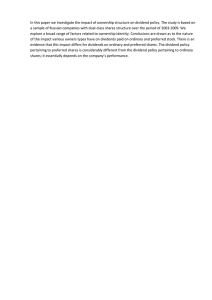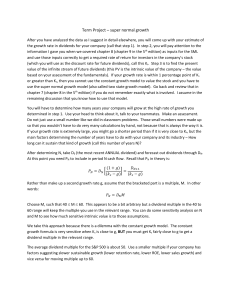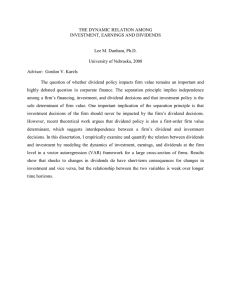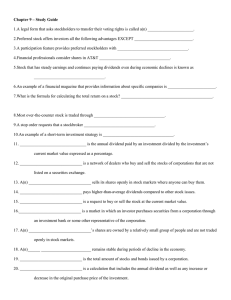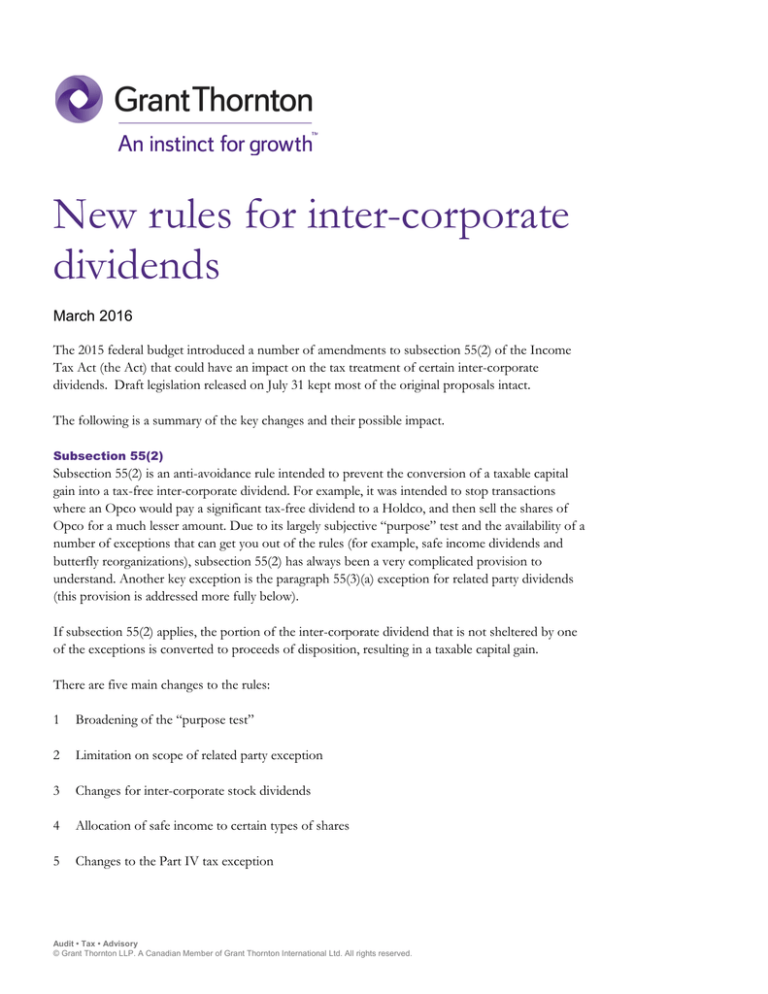
New rules for inter-corporate
dividends
March 2016
The 2015 federal budget introduced a number of amendments to subsection 55(2) of the Income
Tax Act (the Act) that could have an impact on the tax treatment of certain inter-corporate
dividends. Draft legislation released on July 31 kept most of the original proposals intact.
The following is a summary of the key changes and their possible impact.
Subsection 55(2)
Subsection 55(2) is an anti-avoidance rule intended to prevent the conversion of a taxable capital
gain into a tax-free inter-corporate dividend. For example, it was intended to stop transactions
where an Opco would pay a significant tax-free dividend to a Holdco, and then sell the shares of
Opco for a much lesser amount. Due to its largely subjective “purpose” test and the availability of a
number of exceptions that can get you out of the rules (for example, safe income dividends and
butterfly reorganizations), subsection 55(2) has always been a very complicated provision to
understand. Another key exception is the paragraph 55(3)(a) exception for related party dividends
(this provision is addressed more fully below).
If subsection 55(2) applies, the portion of the inter-corporate dividend that is not sheltered by one
of the exceptions is converted to proceeds of disposition, resulting in a taxable capital gain.
There are five main changes to the rules:
1
Broadening of the “purpose test”
2
Limitation on scope of related party exception
3
Changes for inter-corporate stock dividends
4
Allocation of safe income to certain types of shares
5
Changes to the Part IV tax exception
Audit • Tax • Advisory
© Grant Thornton LLP. A Canadian Member of Grant Thornton International Ltd. All rights reserved.
In its 2015 budget, the Department of Finance explained the mischief that it was trying to prevent.
By using an inter-corporate dividend to cause the fair market value (FMV) of a share to fall below
cost or the shareholder’s cost of properties to increase, the shareholder could use the unrealized
loss to shelter an accrued capital gain in respect of other property.
However, the proposals can potentially have a much broader impact than this. They apply to intercorporate dividends received after April 20, 2015.
Broadening of the “purpose” test
One of the most notable differences between the old rules and the proposed rules is the addition of
new “purpose” tests that could cause subsection 55(2) to apply. Under the old purpose test,
subsection 55(2) could only apply where the purpose of the dividend was to reduce a capital gain on
any share of capital stock immediately before the dividend was paid. Although this test continues to
apply, the new added tests are no longer tied to a reduction in a capital gain, but can also apply
where one of the purposes of the dividend is to effect either (a) a significant reduction of the FMV
of any share or (b) a significant increase in the aggregate cost of property to the dividend recipient.
This test can potentially be extremely broad, since the threshold for satisfying the “one of the
purposes” test could be quite low. Adding to the subjectivity involved regarding what would
constitute a “significant” reduction or increase, these new tests have created considerable
uncertainty as to how they will be interpreted by the Canada Revenue Agency (CRA).
Limitation on scope of related party exception
The old rules also provided a related party exception to subsection 55(2) as long as the intercorporate dividend was not paid as part of a series of transactions or events that involved an
unrelated party. This exception applied to all types of dividends—cash dividends, stock dividends,
deemed dividends, dividends-in-kind, etc.—and was commonly relied upon as a means to avoid
subsection 55(2) in related party situations. However, effective for dividends received after April 20,
2015, the rules have been changed so that this exception now only applies to subsection 84(2)
dividends and subsection 84(3) deemed dividends. This now puts all significant cash dividends
that satisfy the “one of the purposes” tests at risk.
Changes for inter-corporate stock dividends
Under the old rules, the amount of a stock dividend for tax purposes was generally equal to the
increase in paid-up capital of the issued shares (generally nominal). As a result, stock dividend
shares could avoid being caught by subsection 55(2) as the amount of the dividend would be
nominal. The proposed changes will essentially deem the “amount” of an inter-corporate stock
dividend for purposes of applying section 55 to be the FMV of the issued shares. Consequently,
high-low inter-corporate stock dividends that were previously not subject to a section 55 risk are
now fully exposed.
Allocation of safe income to certain types of shares
One of the exceptions to being caught by subsection 55(2) is to show that the dividend was paid
out of “safe income.” The proposals have changed the way in which safe income is applied to
dividends. Under the old rules, safe income could theoretically attribute to preferred shares if the
preferred shares were entitled to share in the income of the corporation during the holding period.
It was not always clear as to how this would apply to discretionary dividend preferred shares;
however, this was seldom an issue due to the related party exception.
Audit • Tax • Advisory
© Grant Thornton LLP. A Canadian Member of Grant Thornton International Ltd. All rights reserved.
The proposed rules clarify that no safe income can attribute to dividends paid on discretionary
dividend or dividend streaming shares (on the assumption that such shares cannot increase in
value). Also, since safe income can only be applied to shares with a gain, no safe income can be
allocated to loss shares. This was never an issue under the old rules; however, the new purpose tests
discussed above provide that subsection 55(2) can now apply in loss situations.
Changes to the Part IV tax exception
Under the old rules, subsection 55(2) did not apply to any portion of a dividend for which the
recipient was subject to Part IV tax that was not refunded to the recipient as a consequence of the
payment of a dividend to a corporation (where that payment was part of the series of transactions
or events). The new rules have narrowed the Part IV tax exception by providing that subsection
55(2) does not apply to any portion of a dividend for which the recipient was subject to Part IV tax
that was not refunded to the recipient as a consequence of the payment of a dividend by the
corporation as part of the series. This now includes situations where the corporation receives a
dividend refund by paying a dividend to any person, including an individual, as part of the series.
What does this mean going forward?
A strict interpretation of the draft rules could cause the following types of common transactions
involving inter-corporate dividends to be caught where a) the amount of the dividend is significant
and b) one of the new “purpose” tests is satisfied:
• Asset protection transactions
• Capital gains exemption purification transactions
• The payment of dividends on dividend streaming shares
The CRA has confirmed that standard in-house loss consolidation arrangements, whereby
dividends are paid on preferred shares between related companies, would not be within the ambit
of the new purpose test. On the other hand, a standard creditor proofing technique involving the
declaration of a large cash dividend by an operating company to a holding company would generally
satisfy one of the new purpose tests. In this situation, the company would have to rely on the safe
income exception to avoid having the dividend reclassified as a capital gain. The CRA’s
unfavourable position on this matter has increased the importance of safe income on hand.
The proposed changes to Section 55 have added significant uncertainty and complexity to what was
already a very complex section of our tax rules. The CRA has stated that, over time, this uncertainty
should be lessened as future rulings and interpretations are issued. In the interim, there are means
of structuring most transactions to ensure that one of the exceptions permitted in the Act are met.
Nevertheless, extreme care should always be taken when planning transactions involving intercorporate dividends.
Please contact one of our firm’s tax practitioners if you would like to discuss how these new rules
might impact you and your corporation.
Audit • Tax • Advisory
© Grant Thornton LLP. A Canadian Member of Grant Thornton International Ltd. All rights reserved.
About Grant
Thornton in Canada
Grant Thornton LLP
is a leading Canadian
accounting and advisory
firm providing audit, tax
and advisory services
to private and public
organizations. We help
dynamic organizations
unlock their potential for
growth by providing
meaningful, actionable
advice through a broad
range of services.
Together with the
Quebec firm Raymond
Chabot Grant Thornton
LLP, Grant Thornton in
Canada has
approximately 4,000
people in offices across
Canada. Grant Thornton
LLP is a Canadian
member of Grant
Thornton International
Ltd, whose member and
correspondent firms
operate in over 100
countries worldwide.
The information
contained herein is
prepared by Grant
Thornton LLP for
information only and is
not intended to be either
a complete description of
any tax issue or the
opinion of our firm.
Changes in tax laws or
other factors could affect,
on a prospective or
retroactive basis, the
information contained
herein. You should
consult your Grant
Thornton LLP advisor to
obtain additional details
and to discuss whether
the information in this
article applies to your
specific situation.
A listing of Grant
Thornton offices and
contact information
can be found on our
website at:
www.GrantThornton.ca


